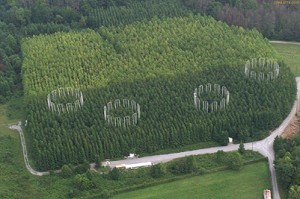12 December 2013
Rooting out carbon’s effect on plant growth

Six 25-meter long plots of deciduous forest at the Oak Ridge National Environmental Research Park in Tennessee. PVC pipes comprise the Free Air Carbon-dioxide Enrichment (FACE) facility. Credit: Oak Ridge National Laboratory
In 1988, scientists at the Tennessee Oak Ridge National Environmental Research Park planted a scattering of Sweetgum seedlings to fill a space equivalent to a running track. Nearly 10 years later, after the trees had matured, construction crews plopped four rings of 40-foot PVC pipes into the floor of the new deciduous forest. In 1998, two sets of pipes switched on and began blowing carbon dioxide into the trees’ air supply, non-stop for 12 years.
While pumping even more carbon dioxide into our increasingly CO2-heavy atmosphere may seem environmentally unfriendly, this long-term experiment will help researchers better understand how climate change may affect plant growth in the future. The research was initiated by Richard J. Norby, an environmental scientist at Oak Ridge National Laboratory, and funded by the Department of Energy.
Colleen M. Iversen, a staff scientist at Oak Ridge National Laboratory in Tennessee, hypothesized that the extra carbon dioxide would stimulate plant growth. And if the plants did increase in size, Iversen wondered what they would do with the extra carbon.
Iversen found that the elevated CO2 levels did, in fact, increase photosynthesis and plant growth by 21 percent. But the team noticed the trees did something surprising. Instead of using the extra carbon to make more wood and leaves, the trees sprouted more roots that plunged deeper into the soil. They grew the type of fine, small roots that take up nutrients and water, but only live for a span of a month or a year, Iversen said.
“We think the reason the trees made more roots is because they were limited by the availability of soil nutrients, like nitrogen,” Iversen said at a poster session Wednesday at the American Geophysical Union’s Fall Meeting.
Nitrogen is an essential building block of amino acids and chlorophyll. Its availability is one of many factors affecting plant growth. Since the trees had access to an abundant source of carbon, Iversen said, they could use the carbon to synthesize roots that could then probe the soil for nitrogen.
But in recent years, the trees stopped growing. Iversen attributed this phenomenon to the limited abundance of nitrogen in the soil.
“Other things aside from carbon are important,” said Iversen. “They need nitrogen to make more biomass, so the increase of plant growth may not be sustainable.”
This finding on nutrient feedback challenges current environmental models, which only look at how plants use carbon. By understanding the role of different nutrients, like nitrogen, on plant growth, scientists can better adjust their models to predict how the increase in atmospheric greenhouse gases will affect the health of vegetation.
“If the models, for example, are thinking the trees are making more wood, but they’re actually making more roots, that has some implications for how we think about the future,” said Iversen.
– Julia Calderone is a science communication graduate student at UC Santa Cruz


 GeoSpace is a blog on Earth and space science, managed by AGU’s Public Information staff. The blog features posts by AGU writers and guest contributors on all sorts of relevant science topics, but with a focus on new research and geo and space sciences-related stories that are currently in the news.
GeoSpace is a blog on Earth and space science, managed by AGU’s Public Information staff. The blog features posts by AGU writers and guest contributors on all sorts of relevant science topics, but with a focus on new research and geo and space sciences-related stories that are currently in the news.